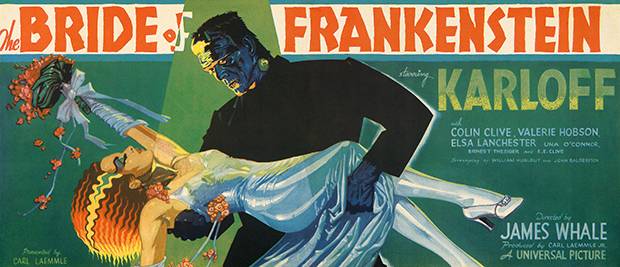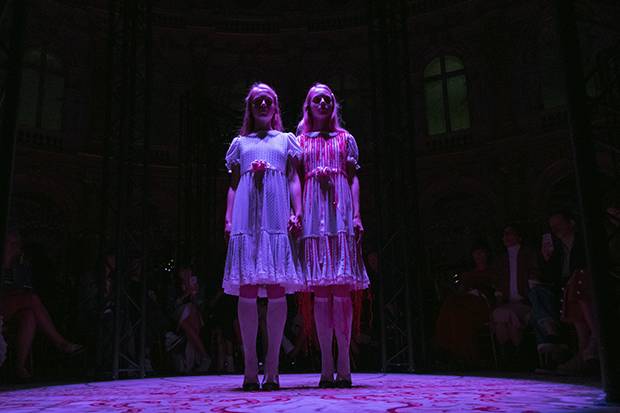If you're dressed to kill this season, chances are the look was influenced by a horror film. Like Nosferatu's lust for blood, designer clothing can't resist references to both the villains and victims of popular culture.
At Jun Takahashi's Undercover show in September, pairs of models wore baby blue dresses with Peter Pan collars – some draped with crocheted red teardrops, like blood – a reference to the creepy twins from Stephen King's The Shining. Yang Li's upcoming spring men's-wear collection references the dark dandyism of lurid slasher movies like Abel Ferrara's gory thriller The Driller Killer, both in the slick 1970s leather silhouette and a phrase from the film used as a slogan on the clothing: "This film should be played loud." Fendi's spring/summer 2018 men's collection offers classic tailoring under sheer patterned blazers and toppers cut to look like American Psycho's plastic raincoat.
There's more to it than merely horror genre cosplay. The grisly and the glam of haute horror has long enjoyed a mutually referential relationship, and the genre is especially high profile right now, largely because of "the myriad TV shows, from zombies to American Horror Story," says Julia Petrov, a curator at the Royal Alberta Museum in Edmonton and co-editor of Fashioning Horror. "It's so much more in our faces."
Petrov's new anthology, due in bookstores on Dec. 14, considers the undercurrent of fashion in horror (and vice versa) from Anne Rice and Angela Carter to the Halloween franchise. Clothing is important to horror and, the book suggests, the grotesque is at the heart of fashion itself, "both as disguise, and carnivalesque subversion," Petrov writes.
For the Calvin Klein label, designer Raf Simons continued his exploration of Americana by remixing the visual tropes of titular horror heroines like Rosemary and Carrie on a set propped with cheerleader pom-pom raffia and axes. Carrie is represented by a delicate mesh dress fringed in shades of crimson and garnet red to resemble the fresh and congealing rivulets of pig's blood that doused Sissy Spacek at prom.

The Bride of Frankenstein, 1935.
Courtesy of Universal Studios Licensing, LLC/ Collection of Kirk Hammett
"Danger is an attractive thing," Petrov says during a phone conversation. "It's sexy, we like to play with the idea of danger – and as long as we're playing, it isn't danger. It's fantasy, almost role-play." She then brings up the enduring influence of Jack the Ripper and Alexander McQueen, whose Central Saint Martins graduate collection was famously a take on victims. McQueen revisited that violence throughout his short career. "On one hand, these are real women who were brutally murdered, and it's about violence against women," she says, "yet the thing that remains in fashion is the sexualization [of that violence]."
The horror genre has linked fantastical, aestheticized violence with high fashion since the birth of Hollywood, from to the magnificently macabre glamour gowns of monster movie damsels in distress to the menacing witches in the hypnotic visual frenzy of Dario Argento's giallo Suspiria.
A slew of early movie posters, rare originals from cult 1930s monster films, are on display in the Peabody Essex Museum's current exhibition It's Alive! Classic Horror and Sci-Fi Art from the Kirk Hammett Collection. (That's right: the Metallica guitarist is an avid collector of graphic art.) From Carl Laemmle's The Mummy, attributed to graphic artist Karoly Grosz, to Universal Pictures' successful Frankenstein and Bride of Frankenstein, the posters depict the damsels in distress in elaborate high fashion.
Universal director James Whale and his enigmatic costume designer Vera West still exert influence today. Their film The Bride of Frankenstein is an especially layered case, Petrov says. "Within the Frankenstein genre but there was lots of additional references," to ritualistic history and death culture, "with bandages to embalming, to Ancient Egypt, to mummies and Nefertiti, in fact. She was a powerful female icon."
All three are visually referenced in Tom Ford's latest runway show. Shirred and gathered jersey recalled actor Elsa Lanchester's Bride garb, down to the glam sequinned, bandage-style sleeves peeking out from the strong retro shoulders of his finale gowns.
They aren't the walking dead but the constriction of models swaddled in dresses recall zombies emerged from mummy cases in other ways.
"Repression is an interesting angle," Petrov adds, and mentions revenant movies (of the undead) to suggest that fashion is a kind of vampire, that it feeds upon itself. "That's an interesting and quite a profound metaphor, that there is this idea of the eternal return in fashion. And equally, in vampIre literature and lore as a whole, like in Anne Rice."
The erotic undercurrent of pleasure and destruction entwined in the artistic imagination, or put another way, cruelty and fashion go hand in hand.
"It's an interesting cycle where fashion in real life can be horrible and horrifying, and then there are particular echoes of that in our cultural imagination that echo across various cultural realms," Petroc says, "whether it's film, graphic novels or literature, or the runway."
The horror, the horror.
Visit tgam.ca/newsletters to sign up for the Globe Style e-newsletter, your weekly digital guide to the players and trends influencing fashion, design and entertaining, plus shopping tips and inspiration for living well. And follow Globe Style on Instagram @globestyle.




